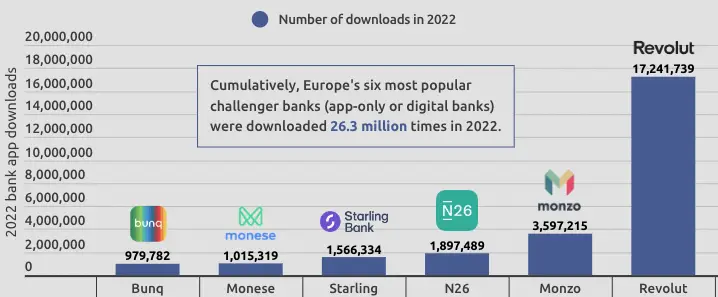Challenger banks vs. crypto institutions: The battle for the future of finance

Over the years, the financial industry has undergone significant transformation as challenger banks and crypto institutions have emerged to challenge the traditional banking system (TradFi). According to data acquired by Finbold, downloads for selected six European mobile-only bank apps peaked at 26.3 million in 2022 for Android and iOS operating systems, representing year-over-year (YoY) growth of 54.09% from 2021’s figure of 17.06 million.
Number of European Mobile-only Bank App Downloads in 2022

Source: Finbold
Similarly, the global cryptocurrency market cap has grown significantly over the past year, reaching a total market value of over $2.5 trillion in early 2022. As digital Banking and crypto adoption gain more traction, the competition to shape the future of Finance is intensifying. Thus, which will come out on top?
Challenger Banks
Challenger banks represent financial institutions that ‘challenge’ the conventional banking sector by operating entirely online.

The likes of Revolut, Monzo, and Wise provide customers with a seamless onboarding process and efficient banking experience. Unlike traditional banks — which require extensive documentation and background checks — these banks typically only require a few simple steps to open an account, often within minutes.
Additionally, challenger banks offer features such as budgeting mechanisms, real-time transaction alerts, and even reward programs to provide consumers with a more enjoyable experience of managing their finances.
Crypto Institutions
Whilst challenger banks have made significant strides in disrupting the traditional system, with the rapid innovation of crypto institutions, there is a growing recognition that the next wave of disruption in finance may come from the world of cryptocurrency. Institutions such as Coinbase and Binance offer many of the same benefits as challenger banks, but with additional features that come with the use of blockchain technology.

Crypto institutions can offer users greater security, faster transaction times, and a range of financial products comparable to TradFi banks including sending, receiving, spending, savings, remittance, trading, and lending. Though furthermore, beyond these conventional offerings, blockchain technology enables these institutions to offer an extended range of services, e.g. decentralized governance mechanisms which prioritize transparency, accountability, and community decision-making too. In addition, they can also offer staking and decentralized finance (DeFi) liquidity provision, empowering users to effectively “become their own bank.”
As transactions are recorded on a public ledger, they are more resistant to fraud and manipulation. Overall, these innovative financial products and services are transforming the financial industry and providing a viable alternative to traditional banking.
The Overlap
Although challenger banks and crypto institutions have distinct characteristics, they share similar financial products.
For example, Revolut, a leading challenger bank, has successfully integrated cryptocurrency trading into its product offering, enabling its users to buy, sell, and hold digital assets such as Bitcoin and Ethereum. This strategic move has enabled Revolut to capitalize on the increasing demand for cryptocurrencies whilst still providing users with an accessible and user-friendly platform.
Likewise, though crypto institutions utilize blockchain technology to facilitate transactions, some, such as Coinbase operate on a centralized platform governed by a central authority. Despite this, Coinbase has recently launched Base, a platform aimed at simplifying the development of DeFi applications on its blockchain.
This move demonstrates Coinbase's adoption of newer technologies and its expansion into DeFi, which could attract users interested in innovative financial products.
Looking toward the future, this convergence presents an exciting opportunity for the emergence of better financial innovation: crypto banking.
Crypto Banking
By incorporating the user-friendly interfaces and modern features of a challenger bank with blockchain’s transactional infrastructure, running crypto-powered financial services has the potential to change the way consumers manage their finances.
A crypto bank can be highly beneficial to not only consumers who are currently banked but face issues with the traditional banking system but also those who may not have access to the traditional system as a whole - the unbanked.
In developing countries, where traditional banks charge high fees and offer limited financial services, a crypto bank can provide a more affordable and comprehensive option to these demographics. In essence, this can be particularly useful for individuals who do not meet the strict requirements of traditional banks, such as a high credit score or substantial collateral.
In addition, a crypto bank could offer faster and more secure transactions than traditional banks, providing a significant advantage to those who rely on remittances from family members who work abroad.
According to the World Economic Forum, global remittances were estimated at $794 billion in 2022, with developing countries receiving approximately $551 billion of the estimated total.
Countries Receiving the Highest Global Remittances

Image: Visual Capitalist
These remittances are crucial for people in low and middle-income countries and are often the biggest contributor to some national economies. In this context, a crypto bank could offer faster and more secure transactions than traditional banks, providing a significant advantage to those who rely on remittances from family members who work abroad.
Final Thoughts
Indeed, the potential use cases for financial services running on crypto-rails are vast and varied, and its emergence represents a significant step forward for financial innovation.
In light of these potential benefits, it’s clear that the answer to the question of which is superior — challenger banks or crypto institutions — is not a binary one. Rather, it’s a matter of recognizing the strengths and limitations of each and exploring the potential of combining them.
The future of finance lies in the middle ground between challenger banks and crypto institutions, where the benefits of both can be leveraged to create something new and better - a crypto bank. This emerging concept is a prime example of how technology can drive financial innovation and create new opportunities for people around the world.
Disclaimer. Cointelegraph does not endorse any content or product on this page. While we aim at providing you with all important information that we could obtain, readers should do their own research before taking any actions related to the company and carry full responsibility for their decisions, nor can this article be considered as investment advice.
Comments
Post a Comment